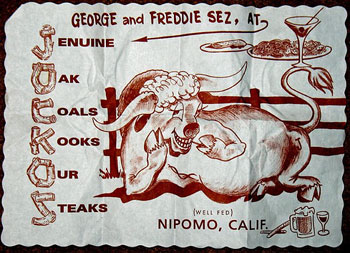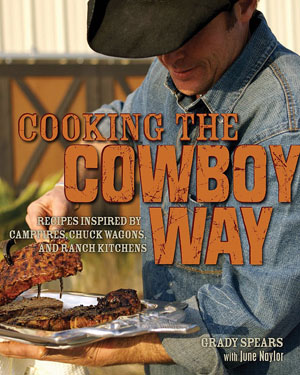 Growing up on the central coast of California was paradisaical in many ways. The natural beauty. The rural feeling. My relatives close by. Farm fresh fruits and vegetables always at hand. Food and family often intermixed. My great-great-aunt Ona Chandler married into the Dana family — a Spanish land grant family dating back to before California was a state when it still belonged to Mexico. Spanish land grants weren’t actually Spanish, they were Mexican. Huge tracts of land that the Mexican government gave away to white men if they married the daughters of Mexican soldiers who were stationed in ‘Alta California’ — the name it had at the time. The goal was to populate the region but it backfired when the white man took the land away from Mexico eventually making it the State of California. The Dana family operated a rancho near the small town of Nipomo — a cow town, full of farmers and ranchers. Cattle was raised in the surrounding hills, and still is. And naturally where there’s beef there’s barbecue. Not just in Nipomo but also in the surrounding area: Santa Maria, Arroyo Grande, and San Luis Obispo. It’s called Santa Maria-style barbecue and the cut used is tri-tip.
Growing up on the central coast of California was paradisaical in many ways. The natural beauty. The rural feeling. My relatives close by. Farm fresh fruits and vegetables always at hand. Food and family often intermixed. My great-great-aunt Ona Chandler married into the Dana family — a Spanish land grant family dating back to before California was a state when it still belonged to Mexico. Spanish land grants weren’t actually Spanish, they were Mexican. Huge tracts of land that the Mexican government gave away to white men if they married the daughters of Mexican soldiers who were stationed in ‘Alta California’ — the name it had at the time. The goal was to populate the region but it backfired when the white man took the land away from Mexico eventually making it the State of California. The Dana family operated a rancho near the small town of Nipomo — a cow town, full of farmers and ranchers. Cattle was raised in the surrounding hills, and still is. And naturally where there’s beef there’s barbecue. Not just in Nipomo but also in the surrounding area: Santa Maria, Arroyo Grande, and San Luis Obispo. It’s called Santa Maria-style barbecue and the cut used is tri-tip.
Santa Maria-style barbecue is a method of outdoor cooking that dates back to the early ranchos and land grants. It is still extremely popular and these days men spend weekends grilling away in grocery store parking lots on mobile barbecue pits; the smell of the oak wood fire, and grilling meat wafting in the air. Because of my Aunt Onie our family has a strong link to the area as well as to this style of cooking. As a child during the summer months the Nipomo’s Men’s Club held community barbecues on the weekends. A pit barbecue was brought to the Nipomo Community Center and the local men grilled tri-tip over oak and served it with homemade salsa, local pinquito beans, salad, and garlic bread. We sat outside at picnic tables covered with white paper and ate until we were full. And boy was it good eating. I have very fond memories of those days. Of those weathered cowboys both white and Latino who pitched in to cook that delicious food; and of the community coming together to feast.

When I received Cooking the Cowboy Way: Recipes Inspired by Campfires, Chuck Wagons, and Ranch Kitchens
for review, I immediately thought back to those summer barbecues. I was excited to see what recipes were included. Campfire, chuck wagon, and ranch cooking is a very distinctive way of cooking and one that I love. There’s nothing quite like the experience, and the flavors, of cooking bacon and eggs, or a steak over an open campfire. The book is a wonderful compendium of this style of cooking. Chef, restaurant owner, and author Grady Spears explores this way of cooking by highlighting working ranches, and their food and recipes across North America. Each chapter is devoted to a different ranch in such states as Texas, Arizona, Missouri, Florida and Alberta, Canada. He includes cooking secrets, photos and stories about the cowboy way of life. While I was reading through it, it made me want to pack up my cast iron pan, and my camping gear, grab my horse, and hit the open road. I have everything but the horse. Maybe car camping is in the near future instead.
I cooked several recipes from the book and they were all a huge success. The recipes were well-written, easy to follow and pleased several friends that came over to eat them to the point that they asked for the recipes for themselves. The ‘Porterhouse Steaks with Wildcatter Steak Rub’ from the Wildcatter Ranch in Graham, Texas were heavenly — the rub is a definite keeper. The salt pork and the jalapeño pepper gave the pinto beans in ‘Tom’s Ranch Beans’ from the Perini Ranch in Buffalo Gap, Texas a full-flavored kick. A sprinkle of chili powder on the ‘Golden Corn Bread Muffins’ from Rancho de la Osa in Sasabe, Arizona provided a welcome boost; and the ‘Autumn Pear Crisp’ also from the Perini Ranch was the hit of the meal. The food and flavors in ‘Cooking The Cowboy Way’ are simple, big and satisfying.
This is not haute cuisine nor should it be. This type of cooking came about because of a need to feed large numbers of hungry men; it had to be easy to prepare as well as filling. It also had to be cooked for the most part out of doors which adds another layer to the cooking and eating experience. To me food always tastes different, better, when cooked outside. The wood fire, the fresh air, the grilling meat are intoxicating. I was a little uncertain when I saw several recipes that listed things like garlic and onion powder, granulated beef base, canned goods, and commercial condiments but then I realized it’s a different style of cooking, that it’s not, as I mentioned, high cuisine, and that some of these ingredients make sense for these recipes. From what I experienced with the recipes I made they had no bearing whatsoever on the taste of the food. I definitely plan to cook more out of this book while checking my food snobbery at the kitchen door. ‘Cooking The Cowboy Way’ is a book worthy of everyone’s cookbook shelves.
Happy trails!
Charles G. Thompson is a Los Angeles-based freelance food writer, whose reviews and stories can be found at his blog 100 Miles, an exploration of local sustainibility.


